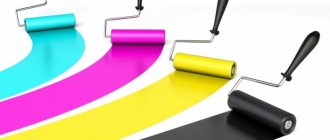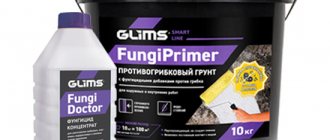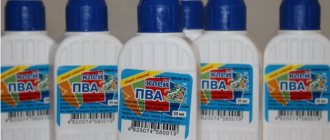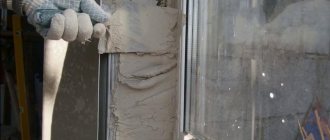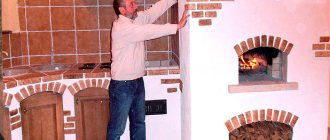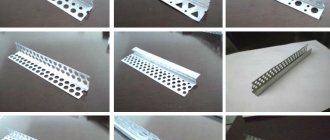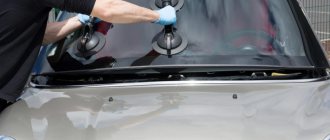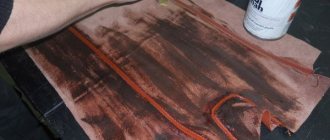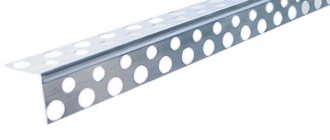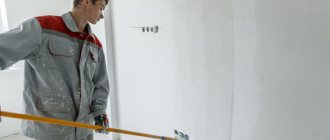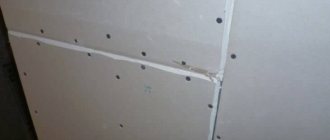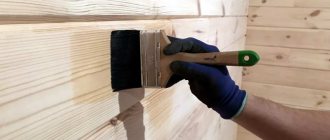During the repair process, it is often difficult to choose a suitable primer, especially if the surface has different materials in structure. It is necessary that the primer is universal, can protect the walls from the negative influence of the external environment and has minimal consumption. In addition, the finish must be firmly on the surface. The acrylic primer meets all requirements.
General information
Depending on the type of primer, they may differ from each other, this provides certain properties:
- Universal compositions provide water resistance to the surface and good adhesion to the subsequently applied finishing.
- An adhesion primer improves adhesion by increasing the adhesion of the substrate to the finish coat.
- Impregnating compositions are used for absorbent surfaces.
- Deep-penetrating primers (penetrate up to 12 cm) level and strengthen walls.
The form of manufacture is also different. Ready-made formulations only need to be mixed thoroughly before use. But mixtures in the form of concentrates must be diluted before use, taking into account the attached instructions.
The primer in the can must be shaken well before use. Cylinders have the lowest consumption, but their disadvantage is that the containers are small in volume.
Advantages and features of choice
The quality of the preparatory work depends on the type of primer, manufacturer, its composition and additional fillers. Acrylic primers are distinguished by their versatility, their ability to strengthen various substrates, and prepare the facade for finishing using paints and putties. Weather-resistant soils are not afraid of mechanical damage and protect the base from wind and moisture for a long time.
Advantages of acrylic primers
An important condition for the use of acrylic primers is their environmental safety. The manufacturer creates a solution that is water-based or contains a small percentage of solvent. Thanks to this, you can prime the rooms inside the house and not worry about the presence of an unpleasant odor. When using solvent-soluble mixtures, you should remember their toxicity, for which it is necessary to use primers for street work. To buy good soil, you need to pay attention to the following nuances:
- Type of surface - if you plan to finish various substrates, then acrylic primers are most suitable for these purposes
- Choice or tinting of color - the peculiarity lies in what type of finishing will be used
- For each material there is a description, thanks to which you can choose a mixture. One type will be suitable for plastic, glass, plaster, varnish, paint, tiled decor, plaster. This is preceded by additional substances that are used in production
- Economical - acrylic mixtures are considered the most economical due to organic resins
- How long will it take for the base to dry - water-based materials tend to dry faster. Water-dispersed primer is optimal for most tasks
- A quality certificate for the material is a mandatory criterion when choosing a primer. Any production of building materials must be accompanied by GOST standards
Important! Poor-quality solutions do not perform their stated functions, and can also be harmful to health, since components of dubious origin may be used in their manufacturing process.
Primers are also distinguished by the form of their release. Stir the prepared solutions well enough before use; they do not need to be diluted. But concentrates need to be diluted until ready before starting repair work. If you are preparing a car or its parts for painting, you can consider the option of using an aerosol primer. The quick-drying solution in the can just needs to be shaken before use.
Purpose and application
The primer is applied to all types of surfaces. This is possible wood, OSB, drywall, metal, concrete blocks. At the same time, the soil not only levels the blocks, but also increases adhesion to various decorative finishes.
Acrylic compositions are also characterized by high hiding power, that is, they contribute to the appearance of a thin protective film layer that has high strength.
Acrylic-based primer is completely safe, which is why it is often used for interior work. They also produce two-component acrylic primer based on organic solvents, which is characterized by high toxicity, but its main purpose is outdoor work.
Advantages of acrylic compositions
The advantages of the material can be described in detail as follows:
- Versatility. Acrylic can be used to process drywall and wood, concrete, OSB boards, metal and other surfaces.
- Improved grip. The ability not only to level the base, but also to increase adhesion with any decorative surfaces that come on top.
- Weather resistance. This primer protects against environmental influences and resists any mechanical damage.
- Covering power. This means that the compositions help create a thin film on the working surface. This film is almost invisible, but is highly durable.
- Environmental Safety. When acrylic primer is made, either a natural water base or a solvent is used. But its amount in the composition is small, no more than 5-10% of other natural components. Non-volatile active substances ensure that there is no unpleasant odor during use, making the compositions suitable for interior treatment of premises. There are solvent-soluble primers, they are slightly more toxic. Recommendation for use – work outside.
- Economical. It is facilitated by low price and consumption per square meter.
Composition and technical characteristics
Depending on the purpose, soils differ in their composition. But there are a number of basic components used in all types of mixtures.
The acrylic primer contains aqueous dispersion, dyes, softening agents, fillers, and catalysts. Also, sometimes specific substances are used, taking into account a specific purpose. Initially, no coloring substances are added to the composition - the manufacturer can produce white or gray primer. But if there is a need, then the color of the required shade can be added to the gray composition.
Depending on the purpose of the mixture, the percentage of a certain substance may vary. The density and drying time depend on this.
Compositions of solutions made on the basis of organic solvents are suitable for outdoor work, since they can withstand any atmospheric conditions well. Mixtures where water is used as a solvent are used for interior work.
Consumption per 1 m2
Consumption is influenced by many factors. If the surface has a porous structure, more soil will be required. If you need to work with such walls, then use a deep penetration primer.
The approximate consumption per 1 m2 is about 120-250 ml. The manufacturer always indicates in the instructions the number of layers required for a particular surface.
Acrylic primer 4+1 HS
Description
Purpose: Used as a leveling (filling) primer when painting new parts and repairing old paintwork.
Packing: 0.6; 1.2 kg
Guaranteed shelf life: 12 months.
- Characteristics
- Additionally
2K acrylic primer “4+1”, hardener for primer “4+1”
Sanded factory finish;
Phosphating primer WASH PRIMER VL-02;
Polyester putty VIKA.
Degrease the metal surface with white spirit;
Repair the surface using VIKA polyester putty;
Dry grinding Р180-Р240;
Optimum temperature +20°C
Minimum temperature +15°C
Relative humidity no more than 75%
Primer:hardener = 4:1 by volume (6.5:1 by weight)
Metallic thinner/acrylic universal thinner 0-30%
25-30 s. at 20°C according to VZ-4 (DIN Cup 4)
5-7 min. between layers, 10 min. before accelerated drying
Tips and recommendations for use
Even a novice master can handle applying primer. To work, you will need a brush, roller or paint sprayer. The process is similar to regular dyeing. But during work it is necessary to take into account certain features:
- When processing one surface, you need to stop using different types of soil on it.
- You need to choose a primer that complies with GOST.
- Areas with a relief surface are recommended to be treated with a brush.
- For walls with a flat surface, it is best to choose a roller. This will save material and create a more uniform layer.
- When working with a paint sprayer, you will need a construction mask. This will protect your eyes and respiratory organs.
Important: For best performance, the primer composition is best applied in two layers.
Priming walls with glue before gluing non-woven wallpaper
Probably everyone dreams of having a beautiful, well-kept and pleasant-looking apartment. In such an environment, everything must be perfect. But the undoubted highlight of any decor is wallpaper. Depending on what material they are made of, what colors they contain and what is depicted on them, the appearance of the room also depends. Today's construction market offers a huge assortment of roll coatings, from which you can choose whatever you like.
In the 21st century it is difficult to surprise. However, the place of one of the most popular and original types of wallpaper went to non-woven fabric. This material has been used by people for a long time, however, in the field of clothing repair. Walls with non-woven wallpaper will not only make your room elegant, but will also add sophistication.
Priming walls before gluing non-woven wallpaper
Having skillful hands and a desire to work, you can refuse the services of professional craftsmen. Wallpapering is a labor-intensive task. It is a mistake to believe that rolls of material can be glued to a previously untreated surface. It doesn’t matter what quality the product is, you first need to prime the walls.
The first step is to carefully examine the surface of the wall. If cracks or chips are found on the surface, they must be repaired. The result should be an absolutely smooth and even surface.
Gluing non-woven wallpaper
After this, you need to carefully putty the surface, which will allow you to achieve an even and smooth coating.
Putty application process:
- Using a large spatula, apply the first layer of the substance. When working, maintain an angle of 45 degrees, since this value is the most optimal for the solution to lay down correctly. The first layer should not exceed 0.2 cm. This is easy to do; it is enough to apply the putty at once without adding more solution. After the wall is plastered, you need to let it dry. This usually takes about a day.
- The second step towards gluing non-woven wallpaper will be to apply another layer of primer. The process is repeated. However, the drying process will not take so much time. 5 hours is enough, it all depends on the internal temperature of the room.
- The final touch is the third coat of primer. This is the finishing line. Here, when working, you can use a medium-sized spatula.
- After all three layers of mortar have dried, you can begin sanding. It is worth noting that this is a long process. However, the end result will undoubtedly please you. You can use sandpaper to wrap the grater.
Thus, priming walls for non-woven wallpaper is not a quick process. It consists of several stages, the correct implementation of which will make it possible to increase the life of the wallpaper.
Priming walls with glue for non-woven wallpaper
However, what to do if it is not possible to use a primer? Is it possible to replace it with improvised means? The answer is undoubtedly yes.
Types of primers with acrylic
Acrylic-based primer can have different properties, taking into account certain tasks and surface properties. For each specific job there is its own type of acrylic mixtures.
By purpose
Depending on the technical characteristics and purpose, the acrylic primer can be:
- Deep penetration. This acrylate primer glues small particles together and fills the porous surface, helping to level it.
- Deep is an improved composition of deep penetration soil. Can penetrate surfaces up to 15 cm, used to treat walls made of old concrete.
- Impregnating. Used to smooth rough walls.
- Adhesive. Improves the strength of the finish, but has weak absorbent properties.
- Universal, having fastening, adhesive and impregnating characteristics.
- The polyacrylic mixture is characterized by high protective and strength properties, but it is also the most expensive and has increased consumption.
By type of solvent
Depending on the type of solvent, the primer can be of the following types:
- Water soluble. It is made on a water or latex basis. Dries quickly, practically odorless, excellent for both interior walls made of plaster, OSB, brick, and for exterior use.
- Organosoluble. It is made on the basis of organic solvents. Improves protection from the negative effects of the external environment, prevents the appearance of fungus.
Depending on the surface to be coated
Strengthening primer is also manufactured taking into account the characteristics of specific surfaces:
- Adhesive. Used for concrete surfaces (concrete blocks, ceilings, floors) with poor moisture-absorbing properties. Used for plastering or painting.
- Deep. Used for treating plasterboard walls or other moisture-absorbing surfaces. This makes drywall much stronger and improves its moisture-repellent properties. Treat before painting or wallpapering.
- For wood and metal. For wood, a one- or two-component composition is used, taking into account the characteristics of the room. For metal, as a rule, a water-based primer with additives is used to protect against corrosion. The compositions are used for painting or can be the final stage of repair.
- Water-dispersed. One-component primers are suitable for treating wood and OSB surfaces. You can add a certain color to the composition for a tint, which will improve the quality of further painting or highlight the texture of wood coated with colorless varnish.
Attention: To check the properties of the acrylic primer yourself, you need to apply the composition to the surface once with a roller. If a varnish film appears, then this is a strengthening primer. Deep penetration soil leaves almost no marks on the wall.
Primer characteristics
The technical characteristics of the product are established by the above state standard. Each batch has a certificate of conformity, a certificate and a hygiene passport. Here are the main parameters:
- the appearance of the film is smooth, without pits, pores, wrinkles, inclusions;
- conditional viscosity according to the VZ-246 device at a temperature of +20 degrees – 20 s;
- degree of grinding – 20 µm;
- share of non-volatile substances – 54%;
- pH of the product – 8-10;
- drying time at a temperature of +40...+50 degrees – 10 minutes;
- adhesion – up to 1 MPa;
- film coverage – 80 g/sq. m.;
- resistance to water at a temperature of about +22 degrees – 24 hours;
- Primer color – white, upon request – brown, black and others.
The resulting coating perfectly withstands temperature changes from –45 to +60 degrees. It will be resistant to precipitation and ultraviolet radiation (does not fade). A layer of dry soil does not pose a fire risk.
Review of popular manufacturers
When purchasing soil from an unknown manufacturer, there is always a risk of buying low-quality products, while global manufacturers constantly monitor the quality of their goods. List of the most popular manufacturers:
- "Prospectors". The mixture has the ability to fill pores and small cracks. The use of quartz sand in the composition improves adhesive properties. It is permissible to use a primer for external and internal work.
- "Optimist". Acrylic primer is suitable for interior and exterior work. This is a mixture of latex with modifying additives and antiseptics. The mixture can be used to treat surfaces that are susceptible to the negative effects of moisture.
- "Tex." A universal mixture that penetrates surfaces up to 7 mm. Due to this ability of acrylic primer, it is used for facades and interior work. Can be used in rooms with high humidity.
- "Knauf". It is a leading global manufacturer in the construction market. Among the large assortment of primers from this company, one can note the polymer composition “Betonkontakt”.
A correctly selected primer, taking into account the required surface characteristics, will ensure the subsequent quality of the finish. The wallpaper will lay perfectly flat on a properly chosen primer, and the painted floor will not crack for a long time. The plasterboard wall will be protected from moisture, and the floor will enjoy a smooth surface for a long time.
Acrylic primer release forms
When you visit a construction supermarket, you can find acrylic primer in 3 forms:
- Liquid. This is the most common form of primer release. In fact, this is a ready-made product that just needs to be poured into a suitable container and you can get to work. Liquid primer is sold in plastic buckets or canisters with a capacity of 2 to 10 liters.
- Pasta. This form of acrylic primer is quite rare on sale. It is sold in small plastic buckets, and before use requires dilution with water in accordance with the instructions.
- Dry mixes. These mixtures are extremely rare on the Russian market. They are also diluted with water according to the instructions, after which they take the form of a familiar primer.
Read also: What is twitching in fishing
